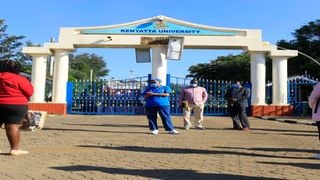
Kenyatta University students at their main gate in 2020. The university is facing a serious cash crisis.
Education
Premium
KRA freezes Kenyatta University accounts
The Kenya Revenue Authority has frozen the accounts of Kenyatta University, causing panic among staff, suppliers and students and opening the lid on the dire financial straits of Kenya’s State-run universities. Sources told the Nation that the shock move was as a result of the university’s non-remittance of statutory deductions running into billions of shillings.
A 2020 audit report indicated that the university owed the taxman Sh2 billion, part of its Sh5.6 billion debt, in unpaid statutory deductions, indicating that while the institution had been collecting pension, salary taxes and health insurance contributions, the money was routinely channelled to other expenditure streams, exposing it to legal action by State agencies.
A senior source at the university confirmed the freeze but said management was negotiating to have it lifted by Friday by paying a fraction of the amount due to KRA. The Nation could not independently verify these claims as the university’s management refused to talk on record, but lecturers told this reporter on Friday that they had started getting their August pay.
The Nation learnt that the university has been unable to meet its daily running operations on account of shrinking revenue and routinely uses bank overdrafts to pay salaries. This month, the university resorted to pay staff using cheques, which were rejected by banks.
Kenyatta University’s financial problems mirror, in many ways, those of other public universities in the country. In the same week that KRA was freezing its accounts, detectives from the Ethics and Anti-Corruption Commission were investigating claims of fraud and embezzlement at Moi University, another academic behemoth that has for years been struggling to stay afloat.
Non-teaching staff
The commission, in a September 7 letter to the vice-chancellor, Prof Isaac Kosgey, is seeking employment records of all teaching and non-teaching staff since July 2018. There are fears that the Eldoret-based university has paid tens, perhaps hundreds of millions of shillings, to ghost workers in the last three years, compounding the financial mess the institution has been grappling with in the last five years.
At Kenyatta University on Thika Road, the imposing gate ushers one to the hallowed grounds of one of the country’s most popular and celebrated learning institutions, but beneath the attractive veneer of the well-manicured grassy lawns and imposing brick-and-mortar structures is an institution gasping for breath.
Years of expansion have seen it extend its reach, in tentacular fashion, beyond the straight and narrow of academia. On the right as you walk in is a mortuary, farther afield is a shopping mall that has been gathering dust since completion, and still further away, nestled in a long-disused corner that borders Kahawa West, is the new Kenyatta University Teaching and Referral Hospital, built on a loan from China and, without a doubt, a major player in the management of Kenya’s Covid-19 problem.
The hospital, however, has become a source of friction between the university and the National Treasury after the government assumed its ownership in January 2019. Records indicate that, while the government transferred the hospital’s assets to itself, it did not assume ownership of the liabilities as well, thus leaving the university with the burden of repaying a loan for an asset it no longer owned.
In June, Treasury wrote to Prof Paul Wainaina, the university’s vice-chancellor, over the matter and noted that it was “aware that the loan contracted by Kenyatta University” was for construction of the hospital, “which has since become a State Corporation” via a 2019 gazette notice.
The letter also indicated that records at the Treasury indicated that the university still owed the Chinese financiers Sh10 billion despite the university’s reports of “nil balance” on the Subsidiary Loan Agreement, and requested the university to transfer the hand-over documents to the national government “to enable us draw a Subsidiary Loan Agreement with the hospital and discharge the loan obligations for Kenyatta University from our records”.
In many ways, therefore, Kenyatta University does not appear to be a candidate for the freezing of bank accounts and its tribulations are exposing, for the first time, the uncertain future of public universities. Its problems, like those of Moi, Nairobi, Maseno, JKUAT and Masinde Muliro, are three-fold: a policy shift in 2016 that allowed the government to fund learning in private universities, the resultant collapse of the once popular self-sponsored programmes, and the effects of the coronavirus pandemic and industrial action on the education sector.
Private universities
Since 2016, when the government started funding students to study in private universities, about 48,000 students have opted out of public universities, and today government-sponsored students constitute up to 50 per cent of the student population in some private universities.
Public universities have been fighting this policy, which they say unduly disadvantages them. In December last year, the vice-chancellors of public universities told Parliament’s Education Committee that they had enough capacity to absorb all students who qualify for degree courses and, as such, there was no need to send students to private universities.
But the chairman of the National Association of Private Universities in Kenya, Mr Simon Gicharu, defended the policy shift, noting that the review of the Education Act had been “a lawful process” and terming as draconian the protestations of the vice-chancellors.
“We will defend the gain,” said Mr Gicharu. “We cannot allow these individuals to take it away.”
Following the declaration of Covid-19 as a global pandemic, approximately 85 per cent of the world’s economies put in place lockdown restrictions for a couple of weeks, according to an International Monetary Fund publication titled Emerging Stronger from the Great Lockdown. As a result, several countries, including Kenya, were faced with appalling fiscal risks such as declining national income, rising debt levels and decreasing revenues due to measures to cushion the population, among them social safety net programmes and tax breaks.
Globally, as governments channelled development expenditure towards mitigating the pandemic, universities had to prepare for the possibility of cushioning themselves against the financial consequences of their operations and maintenance costs. That, in the middle of an exodus to private institutions and dwindling revenue, has proven to be a daunting task for Kenya’s rich crop of public universities, many of whom might not recover any time soon.
Prior to the pandemic, they had been faced with declining tuition fees on account of falling student numbers, particularly in the parallel programmes, due to the downward review of minimum points for admission from B to C+. Initially, the parallel programmes, officially referred to as Self-Sponsored Programmes (SSPs), generated significant revenues for universities. Crucially, despite this policy change, tuition fees for State-sponsored students are capped and have remained constant since 1990.
Besides this, over recent years, seemingly endless strikes by staff have led to extended academic calendars and higher operational costs, thus adversely affected universities’ revenues.
The declining popularity of degree programmes in the country is making matters worse as a sizeable proportion of students is opting to enroll for Technical Vocational Education and Training (TVET) courses in the wake of emerging trends and evolving needs in the current job market.
For instance, the 2019 Kenya Population and Housing Census Volume IV: Distribution of Population by Socio-economic Characteristics report indicates that the number of students currently attending TVET training are marginally higher than those undertaking university courses by 35,126 students.
Correspondingly, the level of formal job creation has plummeted over the last decade compared to informal job creation. Data from the same report shows that private sector formal job creation decreased from 175,000 to 46,100, which translates to a slump of 73.7 per cent. However, private sector informal job creation grew by 7.4 per cent, from 715,200 in 2015 to 767,900 in 2019.
Plunging revenue
Confronted with these realities, most universities have experienced a significant decline in student numbers, coupled with plunging revenue from tuition fees and increased operation and maintenance costs. The Covid-19 pandemic only exacerbated their fragile financial situations.
This week, in the wake of the freezing of Kenyatta University’s bank accounts, the Nation studied its financial health based on the observations of its auditors. The Auditor-General’s report for the year ending June 2020 showed that the university’s pending bills stood at Sh5.6 billion, with Sh2 billion owed to KRA as PAYE, Sh1.2 billion for pension and Sh2.4 billion owed in audit fees and other deductions.
Further analysis of the university’s revenue indicates a massive decline in tuition fees, from Sh6.1 billion in 2015/16 to Sh3.4billion in 2019/20, which translates to a decrease of 45 per cent in earnings. The sharp decline is attributed to introduction of the Differentiated Unit Cost (DUC) funding model in 2017 that seeks to divide total tuition fees between the student, the university and government via recurrent grants.
In light of this, government grants, which represent 50 per cent of total recurrent revenue for the university, stood at Sh3.1 billion in 2015/16 before the new funding model was implemented, and in 2019/20 rose to Sh4.1 billion, which represents a growth of 32 per cent.
However, personnel costs, which constitute 70 per cent of total operating expenses, have outpaced the growth in recurrent revenue owing to implementation of various cycles of Collective Bargaining Agreements (CBA) by teaching and non-teaching staff. Consequently, Kenyatta University has experienced consistent deficits over the last four years. As of June last year the deficit was Sh1.3 billion.





